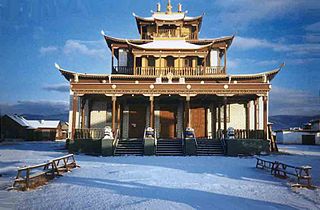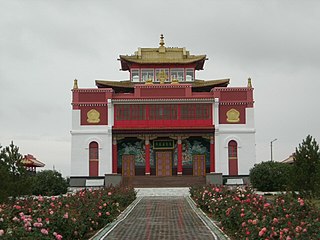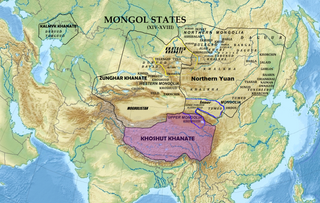
Tibetan Buddhism is a form of Buddhism practiced in Tibet, Bhutan and Mongolia. It also has a sizable number of adherents in the areas surrounding the Himalayas, including the Indian regions of Ladakh, Sikkim, and Arunachal Pradesh, as well as in Nepal. Smaller groups of practitioners can be found in Central Asia, Xinjiang, Inner Mongolia, and some regions of Russia, such as Tuva, Buryatia, and Kalmykia.

The Kalmyks are a Mongolic ethnic group living mainly in Russia, whose ancestors migrated from the Dzungaria region of Mongolia. They created the Kalmyk Khanate from 1635 to 1779 in the south of the European part of Russia territory. Today they form a majority in Kalmykia, located in the Kalmyk Steppe, on the western shore of the Caspian Sea.

The Gelug is the newest of the four major schools of Tibetan Buddhism. It was founded by Je Tsongkhapa (1357–1419), a Tibetan philosopher, tantric yogi and lama and further expanded and developed by his disciples.

Oirats or Oirds, also formerly Eluts and Eleuths, are the westernmost group of the Mongols whose ancestral home is in the Altai region of Siberia, Xinjiang and western Mongolia.
A tulku is a distinctive and significant aspect of Tibetan Buddhism, embodying the concept of enlightened beings taking corporeal forms to continue the lineage of specific teachings. The term "tulku" has its origins in the Tibetan word "sprul sku", which originally referred to an emperor or ruler taking human form on Earth, signifying a divine incarnation. Over time, this term evolved within Tibetan Buddhism to denote the corporeal existence of highly accomplished Buddhist masters whose purpose is to ensure the preservation and transmission of a particular lineage.

Kalmykia, officially the Republic of Kalmykia, is a republic of Russia, located in the North Caucasus region of Southern Russia. The republic is part of the Southern Federal District, and borders Dagestan to the south and Stavropol Krai to the southwest; Volgograd Oblast to the northwest and north and Astrakhan Oblast to the north and east; Rostov Oblast to the west and the Caspian Sea to the east. Through the Caspian Depression, the Kuma river forms Kalmykia'a natural border with Dagestan. Kalmykia is the only region in Europe where Buddhism is the predominant religion.

The Khoshut are one of the four major tribes of the Oirat people. They established the Khoshut Khanate in the area of Tibet in 1642–1717.

Datsan is the term used for Buddhist university monasteries in the Tibetan tradition of Gelukpa located throughout Mongolia, Tibet and Siberia. As a rule, in a datsan there are two departments—philosophical and medical. Sometimes a department of tantric practices is added to them where the monks study only after finishing education in the philosophical department.

Although there was regular contact between practising Buddhists and Europeans in antiquity the former had little direct impact. In the latter half of the 19th century, Buddhism came to the attention of Western intellectuals and during the course of the following century the number of adherents has grown. There are now between 1 and 4 million Buddhists in Europe, the majority in Italy, Germany, Hungary, France and the United Kingdom.

Erdne-Basan Ombadykow, also known as Telo Tulku Rinpoche, is the Tibetan Buddhist spiritual leader of the Kalmyk people. He received his formal training as a bhikṣu in India and was recognized by the 14th Dalai Lama as the current reincarnation of mahasiddha Tilopa.

Geden Sheddup Choikorling Monastery is a Tibetan Buddhist monastery in Elista, Republic of Kalmykia, Russia. It was opened on 5 October 1996 in the presence of more than 30,000 people and is the first Tibetan Buddhist monastery to be built in the region since its beginning as an autonomous oblast in 1920. The monastery also is the Republic's first Buddhist place of worship since Joseph Stalin ordered the destruction of all Buddhist temples and monasteries during the Collectivization era and the Great Purge in the 1930s.

The Burkhan Bakshin Altan Sume is a Gelug Buddhist monastery in Elista, the capital of the Republic of Kalmykia, a federal subject of the Russian Federation. The temple is the largest Buddhist temple in Russia and Europe, and it contains the third largest Buddha statue in Europe — 9 m (30 ft), with only the 10 m (33 ft) tall Miró Buddha in Paris and the 12.5 m (41 ft) tall Buddha in Lagan being bigger.

Historically, Buddhism was incorporated into Siberia in the early 17th century. Buddhism is considered to be one of Russia's traditional religions and is legally a part of Russian historical heritage. Besides the historical monastic traditions of Buryatia, Tuva and Kalmykia, the religion of Buddhism is now spreading all over Russia, with many ethnic Russian converts.

Kyabje Yongzin Ling Rinpoche is a Tibetan tulku. The best-known incarnation is the sixth incarnation, Thupten Lungtok Namgyal Thinley, a Tibetan buddhist scholar and teacher.

The Khoshut Khanate was a Mongol Oirat khanate based in the Tibetan Plateau from 1642 to 1717. Based in modern Qinghai, it was founded by Güshi Khan in 1642 after defeating the opponents of the Gelug school of Tibetan Buddhism in Tibet. The 5th Dalai Lama established a civil administration known as Ganden Phodrang with the aid of Güshi Khan. The role of the khanate in the affairs of Tibet has been subject to various interpretations. Some sources claim that the Khoshut did not interfere in Tibetan affairs and had a priest and patron relationship between the khan and Dalai Lama while others claim that Güshi appointed a minister, Sonam Rapten, as de facto administrator of civil affairs while the Dalai Lama was only responsible for religious matters. In the last years of the khanate, Lha-bzang Khan murdered the Tibetan regent and deposed the 6th Dalai Lama in favor of a pretender Dalai Lama.
Buddhists, predominantly from India, first actively disseminated their practices in Tibet from the 6th to the 9th centuries CE. During the Era of Fragmentation, Buddhism waned in Tibet, only to rise again in the 11th century. With the Mongol invasion of Tibet and the establishment of the Mongol Yuan dynasty (1271–1368) in China, Tibetan Buddhism spread beyond Tibet to Mongolia and China. From the 14th to the 20th centuries, Tibetan Buddhism was patronized by the Chinese Ming dynasty (1368–1644) and the Manchurian Qing dynasty (1644–1912) which ruled China.
Kelden Gyatso (1607-1677) was a 17th-century Tibetan poet, scholar, and siddha. He was the first of the Rongwo Drubchen tulku lineage, and an important figure for Buddhism in Amdo, a region of north-eastern Tibet. The founder of a religious college and a seminary for tantric studies in Rebgong, throughout his life Kelden struggled between his desire to become a recluse hermit and his responsibility to these institutions. While he was ordained and taught in the Gelug school, he had a special affinity for Milarepa, the legendary Tibetan poet of the Kagyu school. The information that survives about Kelden comes from a biography by Jangchup Mila Ngawang Sönam (1636-1716), and from his poetry and songs, both written down and performed today by monks in Amdo.
Tsem Tulku Rinpoche was a recognised tulku of Kalmyk descent, an incarnate lama of the Gelug school of Tibetan Buddhism, and the founder and spiritual guide of Kechara House Buddhist Association with its headquarters in Malaysia.

A khurul is a Buddhist monastery in Kalmyk (Mongol-Oirat) Lamaism. Some of the most famous Kalmyk khuruls are the Burkhan Bakshin Altan Sume (contemporary) in Elista, Republic of Kalmykia, Russia, and the Khosheutovsky khurul.

Khosheutovsky khurul is a Buddhist monastery of the early 19th century and an architectural and historical monument of federal significance. The khurul is located in the village of Rechnoye, Kharabalinsky District, Astrakhan Oblast. It is the only partially preserved Kalmyk khurul from pre-revolutionary times.


















